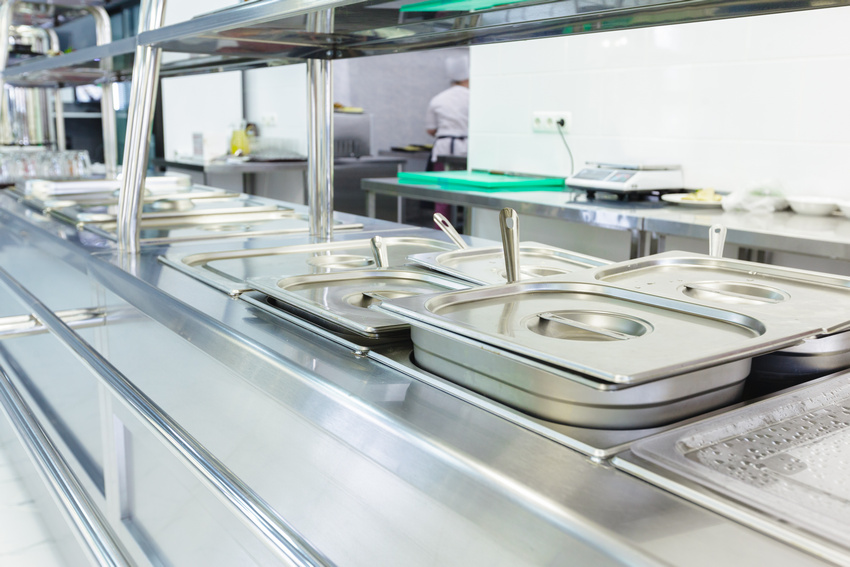The kitchens and dining areas in hospitals and clinics are critical to the well-being of patients, their loved ones, healthcare providers and other facility staff members. These spaces act as central hubs for people to refuel, decompress and nourish themselves and their loved ones while they’re away from home. Because of their important role, it’s vital that kitchens and dining areas be well-designed and modernized to provide the highest level of service.
Understanding the importance of healthcare kitchen & dining design
Healthcare dining spaces typically see a high volume of people each day. If workers can’t easily move through the kitchen to prepare and serve food and beverages, visitors may experience frustration as they try to get their meals and return to their loved ones’ sides as quickly as possible.
Elements of a well-designed kitchen
Kitchen and dining room design trends change frequently. However, some core principles remain the same and are almost always applicable.
The following are some of the key elements of a well-designed healthcare kitchen and dining space:
- Dedicated areas for hot and cold items, desserts and baked goods, specific dietary items like bland broths for post-surgical patients and special meals for patients with food allergies and conditions like diabetes
- Floor plans that ensure visitors can easily move around to get their food, find a seat, etc.
- Easy-to-clean surfaces for optimal hygiene
- Plenty of storage and prep areas to prevent bottlenecks during peak service hours
In many ways, a hospital kitchen operates like a commercial kitchen in a restaurant, just on a smaller scale. Keeping these factors in mind can help designers ensure they’re creating a functional space that works for staff and visitors, alike.
Emerging trends in healthcare kitchen & dining design
For those designing the kitchen and dining room for a new facility or those who want to revamp an existing healthcare kitchen, knowledge of the latest trends can ensure good results and a finished kitchen or dining room that people genuinely want to visit regularly.
The following are some of the most popular trends taking over the healthcare kitchen and dining design space:
Self-service options: In the wake of the pandemic, many restaurants got creative with self-service options, including offering heated pick-up areas where people could grab their meals without coming face-to-face with another human.
Today, many healthcare dining spaces are following suit and offering their own versions of these pick-up areas, which make it easier for visitors to get their food and get back to business (whether they’re treating patients or visiting loved ones).
Multi-functional equipment: Multi-functional equipment allows for increased efficiency and helps save space in smaller healthcare kitchens. Some examples of multi-functional equipment include:
- Ovens that also serve as steamers and rotisseries
- Fryers that can switch from open-air to pressure frying
- Cook stations that can be used for multiple tasks, such as braising, steaming, frying, rethermalizing, etc.
Improved ware-washing stations: Cleanliness and hygiene are, understandably, top priorities. Improved ware-washing stations with washbasin sensors can help kitchen designers achieve these goals.
In the coming years, more healthcare kitchens will feature washing stations that save water and energy without sacrificing cleanliness. They will also include sensors that monitor standing water levels, water temperature and overall cleanliness to ensure dishes are being washed correctly.
Advanced reporting tools: All areas of the hospital or clinic benefit from accurate data collection and reporting, including the kitchen. The following are some examples of data kitchens and dining spaces can gather:
- Wash cycle rates
- Equipment utilization rates
- Wash cycle times (completed/canceled)
- Equipment operational status
- Number of food items prepared
- Demand for specific items
Waste tracking systems: With concern for the environment growing worldwide, healthcare kitchens and dining spaces will also see an increase in waste-tracking systems moving forward. This technology helps to minimize food waste and ensure leftover food goes to those who need it (such as local shelters) instead of ending up in the landfill.
Satellite kitchens: Busy hospitals and healthcare facilities may also start to spread out their kitchens. Rather than having one central kitchen and dining space, they may establish satellite kitchens on different wings or departments to improve access to food and beverages for workers, patients and families.
Challenges in designing healthcare kitchens & dining spaces
The process of designing healthcare kitchens and dining spaces naturally comes with a variety of challenges for designers, construction teams and everyone else who contributes to the project.
Following are some of the most significant obstacles, with suggestions on how to overcome them.
Lack of communication: Poor communication interferes with the design process and overall productivity. By optimizing use of CAD technology and other digital tools, it will be easier for professionals to communicate their ideas, address potential design challenges and correct them sooner.
Insufficient ventilation: Proper ventilation is one of the most important aspects of a safe and well-designed healthcare kitchen. During the design process, team members must make ventilation plans to prevent odors and smoke from moving into the dining room, putting staff and visitors at risk.
Using the wrong building materials: In healthcare kitchens, it’s especially important to choose materials that are durable and easy to clean. Function matters more than appearance, and designers should make sure they’re prioritizing safety and cleanliness over style when creating or updating kitchens and dining spaces.
Shaping the future of healthcare dining spaces
Whether a surgeon needs to grab a cup of coffee before heading to the operating table, or the parents of a sick child need to eat a meal and decompress after a stressful appointment, healthcare kitchens and dining spaces are essential to a well-run hospital or clinic.
By keeping up with the latest design trends, those in charge of building or renovating these facilities can ensure they’re creating food preparation and dining spaces that provide nourishment to all who visit.
For more info, visit microsolresources.com.
Image by Freepik





